Summary of Postmodern Art
Postmodernism is best understood by defining the modernist ethos it replaced - that of the avant-garde who were active from 1860s to the 1950s. The various artists in the modern period were driven by a radical and forward thinking approach, ideas of technological positivity, and grand narratives of Western domination and progress. The arrival of Neo-Dada and Pop art in post-war America marked the beginning of a reaction against this mindset that came to be known as postmodernism. The reaction took on multiple artistic forms for the next four decades, including Conceptual art, Minimalism, Video art, Performance art, Institutional Critique, and Identity Art. These movements are diverse and disparate but connected by certain characteristics: ironical and playful treatment of a fragmented subject, the breakdown of high and low culture hierarchies, undermining of concepts of authenticity and originality, and an emphasis on image and spectacle. Beyond these larger movements, many artists and less pronounced tendencies continue in the postmodern vein to this day.
Key Ideas & Accomplishments
- Postmodernism is distinguished by a questioning of the master narratives that were embraced during the modern period, the most important being the notion that all progress - especially technological - is positive. By rejecting such narratives, postmodernists reject the idea that knowledge or history can be encompassed in totalizing theories, embracing instead the local, the contingent, and the temporary. Other narratives rejected by postmodernists include the idea of artistic development as goal-oriented, the notion that only men are artistic geniuses, and the colonialist assumption that non-white races are inferior. Thus, Feminist art and minority art that challenged canonical ways of thinking are often included under the rubric of postmodernism or seen as representations of it.
- Postmodernism overturned the idea that there was one inherent meaning to a work of art or that this meaning was determined by the artist at the time of creation. Instead, the viewer became an important determiner of meaning, even allowed by some artists to participate in the work as in the case of some performance pieces. Other artists went further by creating works that required viewer intervention to create and/or complete the work.
- The Dada readymade had a marked influence on postmodernism in its questioning of authenticity and originality. Combined with the notion of appropriation, postmodernism often took the undermining of originality to the point of copyright infringement, even in the use of photographs with little or no alteration to the original.
- The idea of breaking down distinctions between high and low art, particularly with the incorporation of elements of popular culture, was also a key element of postmodernism that had its roots in the late-19th and early-20th centuries in the work of Edgar Degas, for example, who painted on fans, and later in Cubism where Pablo Picasso often included the lyrics of popular songs on his canvases. This idea that all visual culture is not only equally valid, but that it can also be appreciated and enjoyed without any aesthetic training, undermines notions of value and artistic worth, much like the use of readymades.
Overview of Postmodern Art
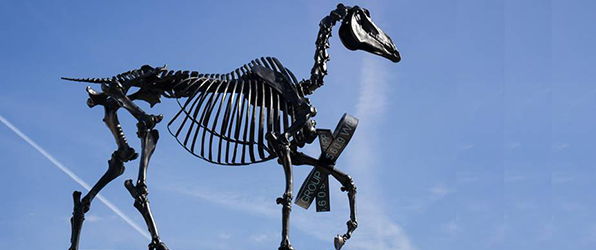
After the horrors of World War II set in, technology continued to grow and dominate, and the world became more interconnected. Artists and theorists drew a line in the sand - they adjusted and a new, "post-ISM" creative period was defined. As the art historian Robert Hewison said "Postmodernism is modernism with the optimism taken out." Here is how it developed and came to be understood.
The Important Artists and Works of Postmodern Art
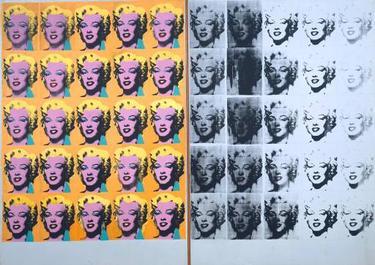
Marilyn Diptych
This series of silkscreen prints of Marilyn Monroe was taken from her image in the film, Niagara and reproduced first in color, and then in black and white. They were made in the months after her death in 1962 by Warhol who was fascinated by both the cult of celebrity and by death itself; this series fused the artist's interests. The color contrasted against the monochrome that fades out to the right is suggestive of life and death, while the repetition of images echoes Marilyn's ubiquitous presence in the media.
This work can be conceived of as postmodern in many senses: its overt reference to popular culture (and low art) challenges the purity of the modernist aesthetic, its repetitive element is an homage to mass production, and its ironic play on the concept of authenticity undermines the authority of the artist. The use of a diptych format, which was common in Christian altarpieces in the Renaissance period, draws attention to the American worship of both celebrities and images. All of these translate into an artwork that challenges traditional demarcations between high and low art and makes a statement about the importance of consumerism and spectacle in the 1960s.
Acrylic on Canvas - Collection of the Tate, United Kingdom

Shuttlecocks
Oldenburg's explorations of banality and art began with soft sculptures such as Giant Hamburger (1962) and Soft Toilet (1966), where he recreated common objects using cushioned materials that belied their solid structures. His works are monumental but placed directly on the floor, dispensing with the pedestal or plinth normally associated with sculpture in a way that literally places the work of art in the viewer's own space. His work use the absurdity reminiscent of Dada's "readymades" to elevate a piece of everyday life to the status of art Shuttlecocks is a later work installed in front of the classical architecture of the Kansas City museum. Through these objects he underscores the larger-than-life quality of popular or low culture - in this case a simple game of badminton on an open lawn - in everyday life. Oldenburg's essay entitled, 'I Am for an Art,' (1961) succinctly expresses his belief that anything can and should be considered art.
Canvas filled with foam rubber and cardboard boxes, painted with acrylic paint - Nelson-Atkins Museum of Art, Kansas City
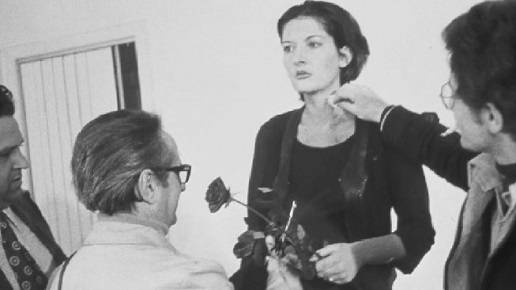
Rhythm 0 / Seven Easy Pieces
Marina Abramovic positioned herself passively in a gallery and invited her viewers to do what they liked to her without any response from her. They were offered a range of objects - each selected for either pleasure or pain, including knives and a loaded gun. After initially provoking a playful reaction, during the six-hour performance she was subjected to an increasing level of aggression, resulting in violent and disturbing occurrences. This pioneering piece broke new grounds in the postmodern shift towards audience participation through its total relinquishing of authorship and control from the artist to the audience, thus challenging the modernist notion of the unique and autonomous artist figure. This piece was typical of Abramovic's tendency to push herself and her body to physical and mental extremes in her performance.
72 materials of pleasure and pain including a gun, a bullet, a comb, a saw, olive oil, cake, wire and sulphur
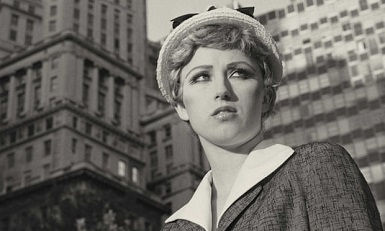
Untitled Film Still #21
This black and white photograph shows a young woman from the 1950s framed by the skyscrapers of the big city, her expression ambiguous - part determined, part apprehensive. We recognize the era from her dress and wonder if this is a still from a film we have seen. This image forms part of an early series of photographs by Cindy Sherman, who plays with the notion of fragmented postmodern identity by taking the role of both photographer and subject. In each shot, she poses as an actress in a range of different settings from different eras, all styled to evoke a moment in time or genre that the audience can recognize and identify with, though these do not originate from any particular film. These therefore exist as simulations or signs with no referent, echoing philosopher Jean Baudrillard's concept of the "hyperreal" society in which it is impossible to identify the real. Sherman's photographs are postmodern in their lack of authenticity and representation of a fluid identity, as well as in their borrowing of historic styles.
This series emerged into a second wave of feminism in which female representation, particularly in cinema, was being questioned. Sherman ironically positions herself both within and outside this media, providing a critique of the notion of a fixed feminine role through her reflexive technique and also subjecting representation itself to question: must women always be shown as victims and martyrs? By bringing this question to the fore, she reduces the power of representations of women.
Black and white photograph - The Museum of Modern Art, New York

The AT&T Building, New York
The iconic 1980s skyscraper is similar in form and scale to its high rise counterparts, but is distinct through its embellishment with a classical broken pediment, Art Deco inspired vertical banding, kitsch pink granite, and elaborate entrance and facade. The design caused notoriety in 1980s America through its stubborn rejection of the Modernist emphasis on clean lines, geometric form, and the idea that "form follows function." Instead, the work appropriates past artistic styles, most notably by Johnson's use of a broken pediment at the crown. This detail is derived from Greek or Roman art, but has also been described as reminiscent of a grandfather clock and a Chippendale highboy. This gesture, along with the use of brick rather than steel as a facing, harkens back to classicism and renounces the purity of form that modernists had worked so hard to achieve. This earned it the title of the first major showcase of postmodern architecture on an international stage.
n/a
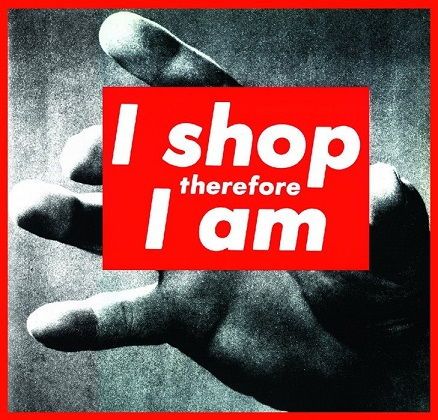
Untitled (I shop therefore I am)
This image is characteristic of Barbara Kruger's style - the juxtaposition of found photographs with aggressive or provocative slogans in a photolithograph that appropriates the direct style and visual form of mass media communication and thus undermines strict distinctions between the imagery, aesthetic and audience for high art and that of advertising. This is evident in the work's stark red, black, and white color scheme and block text that betrays Kruger's graphic design and commercial background. The statement, I shop therefore I am, subverts René Descartes' philosophical claim I think therefore I am, critically referring to the notion that consumerism rather than human agency is now the force that shapes identity - what you buy not your inner life makes you who you are. The work thus underscores in a stark manner the new focus on image and spectacle - a person's value and identity runs no deeper than the surface, encompassing their purchases and the labels they wear.
Silkscreen - Private Collection
Apples Trees
Gerhard Richter is known for his mixing of aesthetic codes and his refusal to maintain a cohesive artistic style, experimenting with gestural painting, sculpture, photo collage, and various other media. At a time when many artists had abandoned painting for performance or installation art, Richter was one of several German artists who revived the medium, but in ways that challenged its traditional qualities, using his experiments to question basic assumptions about the notion of representation itself. He would appropriate his subject matter from newspapers or photographs so that he could focus on the act of painting rather than on deciding what to paint. In Apple Trees, for example, Richter produces a traditional landscape such as one might find in German Romantic landscape painting, but he blurs the image so that details and information about the landscape are not obvious or even available, thus calling into question the point of representational art, which is to represent. He argues that this method keeps interpretational possibilities open by not limiting what the viewer can see.
Oil on canvas - n/a
Michael Jackson and Bubbles
In this piece, Michael Jackson and his pet monkey (and closest friend), Bubbles, are shown life-size sitting on a bed of flowers. The work is a good example of the excesses that characterize Koons' art in terms of color, size, and theme. At the time, Jackson was at the height of his popularity, which Koons underscored by painting the figures in gold in order to make Jackson into a "god-like icon." The gold and white coloring is also reminiscent of Byzantine, Baroque, and Rococo art; this hearkening back to past styles and deliberate theatricality is typical of the camp aesthetic that characterizes some postmodern art. The work was done as part of Koons' "Banality" series and serves as a good example of the kitsch aspect of much of Koons' art in that it valorizes the garish and the sentimental. Like most postmodern art, the work seems to be a deliberate challenge to conventional notions of taste and to the modern separation of high art and popular culture.
Porcelain - The Broad Art Foundation
"Untitled" (Loverboy)
The work of the Cuban artist Felix Gonzalez-Torres addresses many postmodernism issues including originality, the importance of the viewer, the concern with minority identities, and the ephemeral nature of art. "Untitled" (Loverboy), is a stack of paper, from which visitors are encouraged to take a piece. The installation instructions give specific directions to maintain the stack at a certain weight. While the pile shrinks on a daily basis as visitors - with some trepidation - take paper from the pile, it is restored to its full size each morning. Thus, there is no solid, commoditized, always-existing work of art in the traditional sense; it is reconstructed at each installation site with new paper, and the entire piece reconstituted. The work thus questions originality and authorship, while involving the viewer very profoundly in the meaning of the work, which is about the death of Gonzalez-Torres' lover, Ross, from AIDS. As the weight of the pile of paper shrinks each day, this diminution represents Ross's wasting away from the AIDS virus, which he died from two years after the work was first shown. Thus the piece also deals with issues important to the LGBT community - a minority group of people whose rights were just beginning to be recognized.
n/a
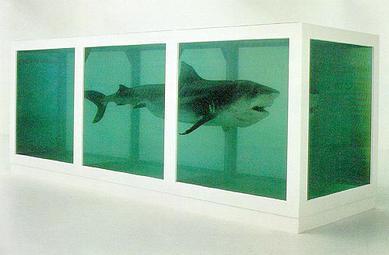
The Physical Impossibility of Death in the Mind of Someone Living
Damien Hirst's shark preserved in formaldehyde is perhaps the most famous work of the Young British Artists movement in the 1990s. Hirst's presentation of a once deadly beast as a carcass that has been preserved to appear lifelike, forces the viewer to confront their fears in the institutional setting of a gallery rather than in a private space, while also playing on Baudrillard's notion of the real and its image. The viewers would have likely only seen an animal of this size and ferocity as an image in a book or on television. Even by having an actual shark placed in the gallery, it may have been difficult for viewers to see the animal as "real" rather than as a replica or simulacra, in Baudrillard's terms, because the shark is dead and has lost its power to harm. The sheer monumentality of the creature and the sense of spectacle - its to-be-looked-at quality - derived from its new status as a commodity art object along with the fact the work was commissioned by dealer, Charles Saatchi at an expense of over 6,000 Pound Sterling in 1991 marked a new era in postmodern conceptual art that did not just draw on the consumerist boom, but wholeheartedly embraced it. This piece was included in the infamous Sensations exhibition along with works by Tracey Emin and Rachel Whiteread.
Glass tank, Steel, Tiger Shark, Formaldehyde - Private Collection
Beginnings
The first signs of postmodernism were evident in the early-20th century with Dada artists who ridiculed the art establishment with their anarchic actions and irreverent performances. The term, however, was not used in the contemporary sense until 1979 in the philosopher J.F. Lyotard's The Postmodern Condition. In art, the term is usually applied to movements that emerged beginning in the late 1950s in reaction to the perceived failures and/or excesses of the modernist epoch.
Modernism
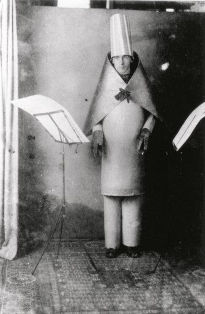
From the late-19th to the mid-20th century, art as well as literature, science, and philosophy was defined by a sense of progress and technological advancement, brought about by the industrial revolution and affiliation with the positivity of modern life. Artists such as Paul Cézanne and Piet Mondrian strove to find a universal means of expression through the increasing abstraction of their subject. Other artists who focused on the subjective and the forbidden, such as Salvador Dalí or Marcel Duchamp were seen as outliers in this emphasis on progress and rationality and their work became precursors to postmodernism. By the 1930s in certain artistic circles, the process of painting, once the means to depict a subject through the use of line, color, and form, became the subject itself. This emphasis on formalism was first observed and championed in the U.S. by Clement Greenberg, an art critic and fierce proponent of modernism. His theoretical writings are often seen as the antithesis of postmodernism because of their advocating of artistic purity and for their singular focus on formalism at the expense of subject matter. By the time the Abstract Expressionists were painting (not yet fancy) in New York lofts in the 1940s, representation had been entirely eliminated in favor of a direct gestural expression that focused on paint application rather than narrative. Fundamental to the modernist avant-garde artist was individuality, autonomy, and the tendency for radical experimentation in search of an ultimate truth or meaning.
The Modernist-Postmodernist Crossover
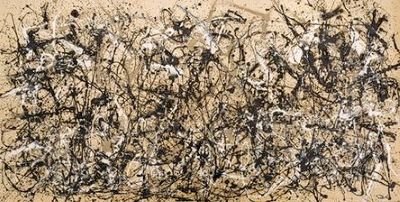
By the middle of the century, the Western world had experienced a major paradigm shift: two devastating world wars, millions of lives lost, communist ideologies shattered, and nuclear weapons utilized. The modernist optimism that had dominated in a pre-war world now seemed irrelevant, outdated, and doomed to fail. Europe was no longer the center of modern art or the avant-garde. The focus of the art world now moved to New York City and to the Abstract Expressionists who were flourishing in a new era of reinvigorated post-war capitalism. This group, however, was still very much marked by their modernism, with the movement staunchly supported by Greenberg as a high art toward which all art had been inexorably moving since the 19th century. Meanwhile, outside this high art enclave, America in the 1950s was experiencing a consumerist and cultural boom as well as a stormy political climate. Once Abstract Expressionism became a mainstream movement, young artists began to question it for its lack of reference both to the state of the world and to the flourishing popular culture of which its artists were a part. Motivated by these feelings and with a desire to create an art that acknowledged everyday life, artists such as Jasper Johns and Robert Rauschenberg began to experiment with new styles that borrowed and recreated imagery from the mass culture that surrounded them. The Neo-Dada style with which they would become associated was arguably the first of the genuinely postmodern art movements. These artists were influenced by John Cage, and many of their experiments would give rise to Pop art and Minimalism.
Concepts, Styles, and Trends
Postmodernism cannot be described as a coherent movement and lacks definitive characteristics. It can be better understood instead as a set of styles and attitudes that were affiliated in their reaction against modernism. A new approach to popular culture and the mass media emerged in the 1950s, sparking a wave of art movements that reintroduced representation from disparate sources and experimented with image, spectacle, aesthetic codes, disciplinary boundaries, originality, and viewer involvement in ways that challenged previous definitions of art.
High vs. Low culture

"High culture" is a term used to describe traditional fine arts, such as painting and sculpture. The term is commonly employed by the art critic to evoke class, quality, and authenticity. It is also used to distinguish types of art media and disciplines from the "low," "kitsch," or popular culture of mass-produced commodities, magazines, television, and pulp fiction that took America by storm in the post-war consumerist boom. In his definitive 1939 essay 'Avant-Garde and Kitsch,' Clement Greenberg warned the modernist avant-garde against association with what he considered philistine outpourings. Greenberg proposed instead that artists' concerns should be reserved for an art that could transform society. The postmodernists, in response, embraced the "popular" wholeheartedly and made it central to their work. Pop artists recreated the mundane objects of consumerism, but used humor and irony to transform these into gigantic soft forms (Claes Oldenburg) or into cultural icons (Andy Warhol) while the Minimalists used industrial materials to create repetitive forms reminiscent of the industrial production line. The "popular" emerged as both the subject and the medium for many artists and commercialism was embraced. This focus on "low" culture stretched the definition of art, while also providing social critique.
Image and Spectacle
In this new era of consumerism and television, advertising and the mass media became increasingly pervasive. In 1968, for example, the American public witnessed uncensored footage of the Vietnam War in their own homes for the first time, providing a stark disconnect with their own comfortable lives as they witnessed the horrors of war over dinner. Images on the screen were reflecting a new reality and it was often more difficult to distinguish between fact and fiction, particularly with the widespread use of advertising. Jean Baudrillard, a prominent French philosopher, called this situation "hyperreality," likening postmodern existence to a flickering TV screen: immediate, shifting, and fragmented, with no underlying truth. These new ideas inspired artists, such as Barbara Kruger, who began to depict the surface rather than any truth or deeper meaning. Style and spectacle, rather than substance, was where meaning was created. This focus on surface is one of the key components of Kruger's I Shop therefore I Am (1987) as well as much of Pop art. Simultaneously, a camp aesthetic was born, particularly evident in fashion and music, that drew from past styles of Gothic and Baroque; the more dazzling, flamboyant, and shocking - the more effective. The work of Jeff Koons is a good example of this aspect of postmodern art.
Mixing of Aesthetic Codes
Modernism had first emerged in 19th century France in rebellion against the historical and figurative preoccupation of the French Academy and its dominance over artistic taste. The avant-garde movements that followed in the early-20th century gradually eliminated any references to a context or subject, in search of a pure and unmediated form of visual expression that was radical and new. This trend reached its apogee with Abstract Expressionism, which championed non-representational painting. However, in the decades that followed the movement, painting as a medium was considered cliche with little room left for experimentation. With the advent of postmodernism, some artists began exploring past styles and media - particularly painting - as part of the postmodern aesthetic that brought back both the historical and the subjective but with a purposeful lack of stylistic integrity or unity.
Artists such as Gerhard Richter playfully mixed aesthetic codes and genres, displacing existing meaning in structures and creating new ones. Using methods of parody and pastiche, old ideas could be recreated in new contexts. As the Dadaists had done earlier, other artists used collage, assemblage, and bricolage that juxtaposed text, image, and found objects to create layered surfaces. This mixing of codes is particularly evident in the architecture of the 1980s and 1990s, such as The Sainsbury Wing of the National Gallery, UK that combines features from two different historical periods into one visual spectacle. In film, the effect could be enhanced considerably. For example, Quentin Tarantino's, Pulp Fiction (1994) defies traditional narrative, drawing from multiple genres and offering a fragmented montage of characters and plots in an arbitrary order. Many artists also turned to multimedia technologies during the 1960s and 1970s, relishing the new opportunities that they were afforded to combine media and to create spectacle and sensation.
There were not just opportunities with new multimedia technologies; from the 1950s and 1960s onwards, there was a significant crossover between artistic disciplines as traditional categories were superseded. A popular postmodernist phrase was "anything goes," which referred both to this growing convergence culture as well as to the collapse of the distinction between "good" and "bad" taste and the difficulty of assigning value or judging works of art based on traditional criteria as in the case with Jeff Koons. Artists adopted the mechanisms of both art and non-art forms, such as advertising, using a multitude of media to convey multiple messages.
Originality and Authenticity
In 1917, Marcel Duchamp placed a urinal signed with a fictional name in an exhibit and called it art. In doing so he mocked the entire foundations on which the institution of art had been built. Traditionally, uniqueness and originality gave an artwork its value or "aura," both in symbolic and monetary terms, and was a concept preserved through modernist art criticism. In 1936, cultural theorist, Walter Benjamin, wrote a seminal essay entitled "The Work of Art in the Age of Mechanical Reproduction," which radically reworked this view, laying charges of elitism at the feet of key figures such as Greenberg. Benjamin claimed that mechanical reproduction, through printing and other methods, could achieve the democratization of art because of its lower commodity value and increased accessibility to the masses. (The fact that one could afford to buy, for example, a poster of Van Gogh’s Sunflowers, and then hang that reproduction on their own living room wall, would be a cause for celebration for Benjamin.)
Pop artists, Minimalists, Performance artists, Conceptual artists, and others adopted Benjamin's ethos, interpreting his words through a diverse range of media and techniques that undermined concepts of authenticity and value and distorted commoditization. Roy Lichtenstein and Andy Warhol mass-produced bags and mugs, screen printed with iconic imagery. Donald Judd and Sol LeWitt exhibited their repetitive forms, but left control of their arrangement to the curator; Allan Kaprow, Marina Abramović, and the Fluxus artists put on performances in which the audience and not the artist determined their form and meaning. Artists of all stripes, including Warhol, Richter, and Koons, were known for their appropriation of photographic and other imagery. Within Feminist art of the 1970s and again in the 1990s, among certain artists there was a surge of interest in the idea of collective authorship that further undermined traditional ideas of creativity and artistic genius that had been in place since the Renaissance. Artists such as Daniel Buren were increasingly concerned with the social process of art making rather than the art object, and placed the creation of meaning at the point of interaction. This new practice became known as Relational Aesthetics, and resisted commoditization of art through its performative nature, providing a powerful criticism of the art world, a field that came to be known as institutional critique.
Poststructuralism
The philosophical arm of postmodernism stems from intellectual shifts in France that occurred during the second half of the 1960s. The concept of poststructuralism is associated with the likes of Roland Barthes, Michel Foucault, Jacques Lacan, and Jacques Derrida. But it was Barthes’s 1967 essay, “The Death of the Author” - in which he famously proposed that the birth of the reader must come at the cost of the death of the author - that brought about something of a revolution in the way we think about, and interpret, art. For Barthes, works of literature or art (or any text for that matter) were never original but rather made up of “a tissue of quotations” from previous and existing works.
For Barthes, then, to “impose” an author on a text merely limited its scope whereas the text had the potential to offer infinite reading possibilities (structuralism had proposed rather that by deconstructing a text semiologically then one could uncover a single “fixed” societal meaning/structure). The belief that the individual interpreted the text for themselves - the idea, in Barthes’s words, that a text’s meaning lay “not in its origin but in its destination” - led thus to revisionist accounts of a canon that was hitherto dominated by the life stories of the great (typically white) men of western art. Many have questioned the validity of Barthes’s claims (Barthes himself even admitted that when reading “I desire the author”), and even though the author never literally died (postmodernists became the new authors after all), his essay ushered in the era of critical theory whereby “truths” (plural) challenged the idea of “truth” (singular). Poststructuralism supported thus the idea of pluralism and gave special impetus to those theorists and artists interested in pursuing ideas relating to “otherness” and identity politics.
Pluralism
The postmodern pursuit for a democratic art extended beyond reproduction, appropriation, and experiments in collective authorship. Postmodernism coincided with the rise in Feminism, the Civil Rights movement, Queer theory, the fight for LGBT rights and postcolonial theory, and provoked a call for a more pluralistic approach to art. Many artists, such as Kara Walker and Felix Gonzalez-Torres, began to address subjects from multiple perspectives. The collective impact on the arts was an increased representation of diverse, multicultural identities and also a playful treatment of identity and the self. This trope was perhaps most evident in the early works of artists such as Barbara Kruger or Cindy Sherman. It is especially true of Sherman whose work focuses on the rift between an identity constructed through film or other media and the lived experience of women. Sherman’s goal is to draw her audience's attention to the means of image production and that image’s potential for a fluid – or “polysemic” - treatment. Sherman’s work thus resists the master narratives of art history and undermines the authority of the artist.
Later Developments
There are currently two main theoretical approaches to understanding postmodernism, its relation to modernism, and its place in the contemporary art world.
Continual Build-up on Modernism
One argument is that postmodernism both disrupts and continues modernism as there is evidence of both existing in contemporary art, which is a term that broadly refers to any art created within the last twenty years, thus encompassing all art production of any style. The attitudes and styles that mark postmodernism can be understood as paradigmatic shifts that mark a rupture or crisis in cultural history. From this viewpoint, the impact of postmodern, post-colonial and post-feminist theory has sparked a sea of change in art, described by feminist writers such as Rosalind Krauss and Suzanne Lacy. Certainly, the diverse, ephemeral, globally focused, cross disciplinary, and collaborative nature of contemporary art practice is informed by postmodernist attitudes and appears both persistent and transformative. Postmodernism claims to close the gap between "high" and "low" culture and "good" and "bad" taste, yet there is evidence that these distinctions remain.
For example, in the early 1990s, a group of young Goldsmiths College students put together a graduate show called Sensations – it was what we might consider a highly postmodern concept. The reaction to the exhibition was unprecedented. Public and critics alike expressed outrage at the provocative imagery and explicit references to subjects of "bad" taste. The group became known as the Young British Artists (YBAs) and sparked a revival in Conceptual Art using shock tactics to question art's meaning, as Duchamp had done nearly 80 years earlier. Their notoriety has persisted, as has the furor over Sensations, providing evidence for some that the old taste hierarchies of modernism live on. With this argument, postmodernism has not displaced modernism but is rather an extension of it.
The Age of Post Postmodernism
Another view, which has recently emerged in a small but persuasive body of writing, argues that we have moved into a “post postmodernist” era. Some writers and critics claim that postmodernism is outdated and they question the value of a movement sustained by superficiality, cynicism, and nihilism. Some even argue for a return to the principles of modernism, albeit in different forms. Edward Docx calls this post-postmodern era the "Age of Authenticity" characterized by a revival of authenticity and craftsmanship over style and concept. Other monikers include "alter modernism," which is Nicolas Bourriaud's term for the "nonstop communication and globalization" culture of today, and "pseudo modernism," which was coined by Alan Kirby. Kirby claims there has been a shift from audience spectatorship to a more active yet trivial participation, citing as evidence the reality-TV-watching culture. These attempts to claim the end of postmodernism are wide-ranging and generally nonconsensual but are united in elements of their critique of the postmodern concept. Weary of the relentlessness of postmodern irony and cynicism, these critics yearn for some return to truth and authenticity. In different ways albeit, they undermine postmodernism's dominance as a way of thinking or as an attitude to life, reducing it instead to one movement in a long history of movements, one that is now in decline.
Useful Resources on Postmodern Art
- Postmodernism, or, The Cultural Logic of Late Capitalism (Post-Contemporary Interventions)By Frederic Jameson
- Simulacra and Simulation (The Body in Theory: Histories of Cultural Materialism)Our PickBy Jean Baudrillard
- The Parameters of PostmodernismOur PickBy Nicholas Zurbrugg
- Art of the Postmodern Era: From The Late 1960s To The Early 1990sBy Irving Sandler
- Post Modern Art: 1945-NowBy Francesco Poli
- The Disappearance of Objects: New York Art and the Rise of the Postmodern CityBy Joshua Shannon
- Signs of Psyche in Modern and Postmodern ArtOur PickBy Donald Kuspit
- The Postmodern Arts: An Introductory Reader (Critical Readers in Theory and Practice)Our PickBy Nigel Wheale
- Postmodern Perspectives: Issues in Contemporary ArtOur PickBy Howard Risatti
- The Cambridge Introduction to PostmodernismBy Brian McHale
- An Introductory Guide to Post-Structuralism and PostmodernismBy Madan Sarup
- Photography after PostmodernismOur PickBy David Bate
 Ask The Art Story AI
Ask The Art Story AI












